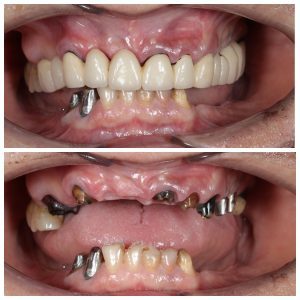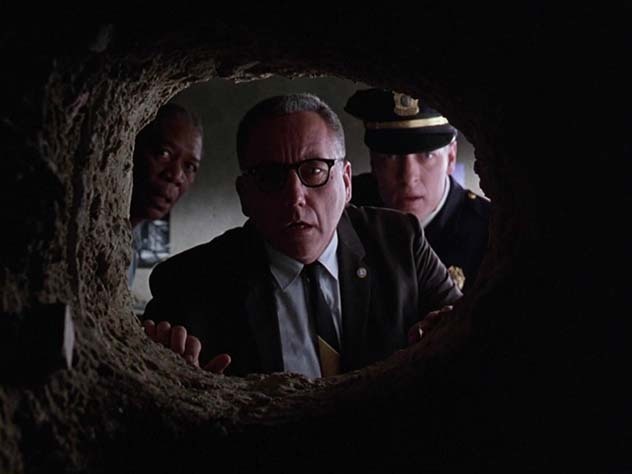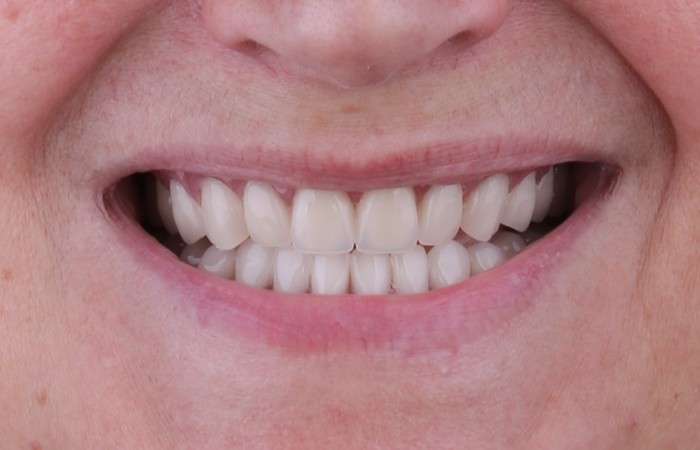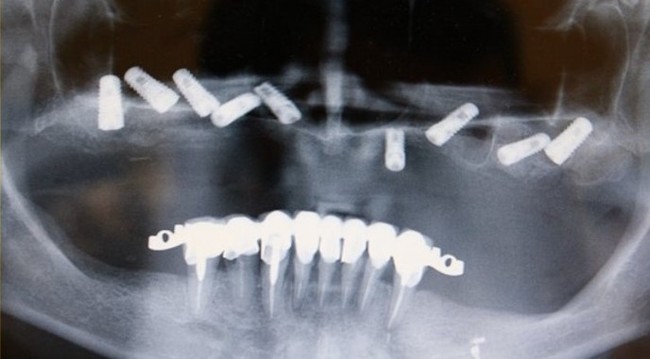Implantation in the absence of teeth, as a result of late appeals to the dentist

Dear friends, glad to welcome you again! We have already discussed a lot on the topic of wisdom teeth, which are , how they are removed , it does not hurt, that means everything is in order , there is nothing to do in the laboratory and even more so “pull them out” . I am very pleased that many of you liked the articles, but today I will continue the topic of implantation.
We all know that our people go to doctors in exceptional cases. Then, when it's too late. A trip to the dentist is no exception. Of course, this does not apply to Habr users, but I would like to tell, and most importantly, show you how this could end.
So, let's begin!
')
Why is everyone so afraid? What stops them? Each has its own reason. If we talk about dentistry, in my opinion there are two main ones, it is the fear that it will hurt (or even more painful than it is now) and the fear that it will be expensive. It’s better to spend this money on a vacation, a new car or ... 8PACK OrionX. Everyone's priorities are different.
But few people think that an untimely visit to a doctor can only aggravate the situation. Often, as long as you think “I will tolerate it myself,” the situation can worsen up to the appearance of serious complications, in which the only way is to call an ambulance. But it also happens that many dental problems are asymptomatic and can only be detected by chance. So “it doesn’t hurt, okay”, later it comes to the fact that none of the teeth can be saved and you have to delete them all. And as we know, the greater the volume, the harder the work and the higher the cost. Whatever the scope of this concerns. Therefore, it is extremely important to visit the dentist every six months in order to track all these "does not hurt" in a timely manner. Why half a year? It is believed that for no more than six months, it is possible to detect and eliminate the problem even at the initial stages of its development.
Here is one example.

The patient is quite anxious about the teeth. As we can see, she was actively engaged in the treatment and restoration of teeth. But time passes, and consequently, the service life of fillings, crowns and bridges has come to an end. In addition to spoiling your teeth, problems can begin with implants, as in this case. The latter also have to be deleted. Not to mention the fact that some doctors are still installing plate implants without any indication. Which can break very easily, as in this case. Why all? Yes, because there was no integrated approach, treatment plan and vision of the situation. Tell me, why was a thin plate “shoved” here with such a width of bone? But surely the conditions were even better before the operation. Well, no worse than that for sure.

The only correct solution would be to remove the plate implant. Although ... the removal is putting it mildly. It will have to cut out. What I mean? And I mean, YOU ARE PI. After this word, somewhere on the horizon, a Billy doll riding on his bike begins to slowly but surely approach, and the ability to adequately perceive information slowly disappears, agree.

As we know, plate implants lack integration. This means they do not grow together / do not take root in the bone. Hold only mechanically. When a bed is formed under the implant, a “trench” is made along the alveolar ridge, where this plate is placed in turn. Over time, bone tissue grows into the holes of this implant. And it turns out something like a castle. Therefore, in another way except by the fact that I indicated above, it cannot be removed. You say, but does the usual cylindrical implant have to be removed in the same way? Akey, now compare the wound area when removing the plate about 2 cm in length, and the cylinder, an average of 4.5 mm in diameter. There is a difference? Moreover, if for some reason problems arise with a cylindrical implant, then, as a rule, it either did not integrate (did not merge with the bone), and consequently, it can be reached with the fingers, or there was a critical loss of bone tissue around the implant, as in this case. Often, the work of a drill or ultrasonic tip is minimized, as well as trauma after manipulation. Although, of course, this does not detract from the difficulties that are associated with the restoration of the volume of lost bone in this area. As usually there is an impressive “hole”.

So, after the results of the diagnosis, the consultation of the orthopedist and, importantly, the wishes of the patient (!) Were taken into account, the decision was made to remove all the teeth in the upper and lower jaw, including the previously installed implants. In addition to the plate, I left it for dessert.
Think of it all? Can we start? No matter how wrong! At this stage, new fears begin, such as - “What!” Delete everything at once ?! ”,“ Will I even survive? ”,“ How will I chew on my gums then? ”

In fact, this is nothing dangerous. Nothing threatens your health, much less life. Moreover, no one without teeth from the clinic will let you go. Before the orthopedic procedure is removed without fail, the jaw casts are taken, and afterwards, full removable dentures are made by a technician in the laboratory. After the work gets to the clinic, the patient is recorded for tooth extraction, and then immediately after the fitting and delivery of the structure in the form of temporary prostheses. This means that as you come to the clinic with your teeth, you will leave it too.
Before and after removal:

Temporary denture, tried right after the teeth were removed:

Before proceeding with the implantation, it should take about 2 months to complete the healing of the wound. There is no point in waiting for more than this period, the bone will not grow from this, but a decrease in its volume will become more pronounced with time. The jaw certainly does not resolve, but with a long absence of a tooth, and, consequently, the load in one area or another, the bone tissue slowly begins to decrease. The longer the delay with the restoration, the worse the conditions will be at the time of implantation. This means that the probability and need for bone grafting will only increase.
Well, two months behind and it's time to start implantation! But how to install implants, if there is not a single tooth? What to focus on so that they stand exactly, and in their place? We can not put them anyhow. To avoid this:

Therefore, a surgical template is used. A special kappa, which is very similar to a sports one, with only one condition, there are holes in it in the area of those teeth that will be implanted in the future. This is required so that the surgeon can understand exactly where the implant should be. Below is a positional pattern that serves only for marking:

In the case of this patient, the manufacture of a separate surgical template is not required. An orthopedist with the help of cutters forms similar holes in the most temporary prosthesis, which will serve as a template. After the operation is performed by the same doctor, these openings will be repaired with a special material and it will be possible to continue using the prosthesis until the permanent construction is made. And no, putting it in a glass of water before bed will be unnecessary.
In the panoramic image below in the middle, contrasting “white cylinders” are clearly visible, this is precisely the very material with which the holes in the upper denture were closed. The prosthesis itself is not radiopaque, so it is not visible in the image.

Well, for dessert. Behold Here it is, CREATION! This is what I said, a plate implant with holes in it, into which bone tissue has grown. Well, the broken "pin", which was one of the supports for the bridge.

What was the other support, you ask? Drumroll. Your teeth! Fang and the first premolar (4). The patient brought the picture. It is quite ancient. Film and not the most clear, but that is. (Photographed on the phone)

Someone will think, what's wrong with that? Well, implant, well, tooth. Bridge and bridge. And the fact that the teeth have a ligament apparatus, one of the functions of which is depreciation. That is, when chewing, the teeth are somewhat “springy” when, as the implant is rigidly fixed in the bone and deprived of this function. It turns out something resembling a lever. There is an overload of the transition area "pin" in the body of the implant, as a result of its fracture.
Well, let's summarize!
Dear friends, you must understand that neither a large amount of work, nor the removal of all teeth, nor bone plastics, nor the number of implants are terrible. The only thing terrible is that I will tolerate one small thing, it can turn into a big one “should have been yesterday”. The more and longer you endure, the longer and longer your treatment will turn out. Brushing your teeth in time can prevent tooth decay. Having healed caries in the initial stages, you save yourself from its complications in the form of, for example, pulpitis or periodontitis. Having cured pulpitis or periodontitis in time, tooth extraction will bypass you. Timely restoration of a lost tooth, will save you from bone plastic, etc. After all this, to say that a timely appeal to the dentist, and to any other doctor, will protect you from unnecessary nerves and expenses, I think it makes no sense. Here and so everything is clear without words. Therefore, brush your teeth, pull up and let's meet more often on preventive examinations than with problems with teeth.
Stay Tuned!
Sincerely, Andrei Dashkov
What else to read about the implantation of teeth?
- Implant placement: how is it done?
- Sinus lifting and simultaneous implantation
Source: https://habr.com/ru/post/459956/
All Articles